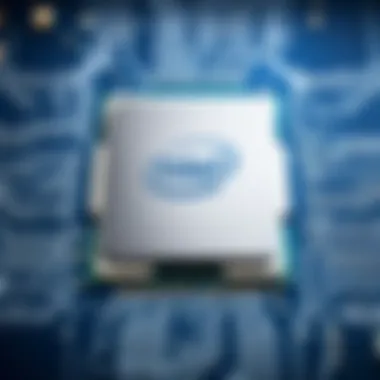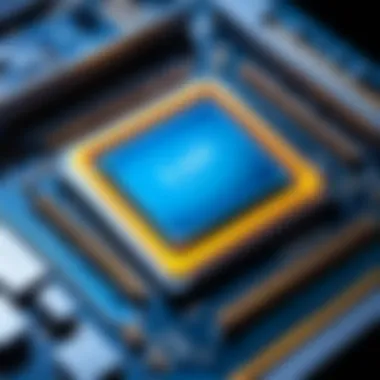Exploring the Latest Intel Desktop Processors


Intro
In the fast-paced world of technology, staying updated on hardware advancements is vital for IT professionals and tech enthusiasts. The latest Intel processors for desktops exemplify this evolution, offering not only significant performance improvements but also enhanced efficiency and compatibility for a range of applications. This exploration aims to dissect these innovations, helping readers understand the implications of these new developments on their work and projects.
Hardware Overview
Specifications
The latest Intel desktop processors, particularly from the Core series, encompass a variety of specifications that cater to diverse user needs. The most recent models, such as the Intel Core i9-13900K and the i7-13700K, boast a hybrid architecture. This approach integrates performance cores (P-cores) and efficient cores (E-cores) to optimize performance while conserving energy.
Key Specifications:
- Cores and Threads: The i9 variant features 24 cores and 32 threads, while the i7 model includes 16 cores and 24 threads.
- Base and Boost Clock Speeds: Base speeds average around 3.0 GHz, with boost speeds reaching up to 5.8 GHz in the i9 version.
- Thermal Design Power (TDP): The TDP for the i9 is rated at 125W, allowing for robust performance under load without excessive heat generation.
Performance Metrics
Intel's latest processors do not just focus on specifications but also deliver measurable performance advantages across a spectrum of applications. Recent benchmarking results have demonstrated impressive gains compared to previous generations.
- Single-Core Performance: Higher clock speeds and architectural improvements lead to enhanced single-core performance, vital for tasks such as gaming and certain productivity applications.
- Multi-Core Performance: For multitasking and demanding applications like rendering or simulations, these processors exhibit superior multi-core performance, leveraging both P-cores and E-cores effectively.
- Thermal Management: Enhanced thermal performance allows these processors to maintain efficiency under heavy loads. The integrated thermal solution, combined with new manufacturing technologies, facilitates better cooling management.
"The advancements in Intel's latest processors can dramatically influence decision-making in hardware selections, particularly in environments prioritizing performance and efficiency."
Software Analysis
Features and Functionality
Intel’s processors come with an array of features designed to enhance user experience and system performance. Technologies such as Intel Turbo Boost Max Technology ensure that tasks are executed swiftly and efficiently. Furthermore, Intel Thread Director plays a crucial role in optimizing task allocation between the different cores, allowing for improved performance depending on workload.
User Interface and Experience
While the processors themselves operate at the hardware level, the impact on the user experience is substantial. Enhanced computing speeds and capabilities reflect directly in applications and software interaction. IT professionals will find that common applications load faster and perform better with the latest processors, contributing to a smoother workflow.
The shift toward a more integrated approach in the design of these processors illustrates Intel's commitment to meeting the demands of modern computing environments. Such considerations resonate significantly with the tech-savvy audience, providing essential insights as they navigate hardware decisions.
This detailed exploration arms readers with a clear understanding of Intel’s latest offerings. As technology continues to evolve, informed decisions regarding hardware selections will ensure sustained performance and efficiency.
Prolusion to Intel Processors
Intel processors are at the core of desktop computing, influencing performance, efficiency, and compatibility across various systems. The evolution of these processors reflects advancements in technology and changing demands from users. Understanding this topic is crucial for IT professionals and tech enthusiasts as it provides insight into the technical specifications and capabilities that modern processors bring to the table.
Historical Context
Intel has been a market leader in microprocessors for decades. The company's journey began with the introduction of the Intel 4004 in 1971, which was the first commercially available microprocessor. Over the years, Intel introduced various architectures like the x86, which became a standard in personal computing. The development of the Pentium processors in the 1990s marked a significant leap in performance with features like superscalar architecture and advanced cache management.
With each architectural iteration, Intel addressed key limitations from previous generations. This historical perspective reveals not just a trajectory of technological advancement but also Intel's response to competitors and market shifts.
Significance in Desktop Computing
Intel processors hold substantial significance in desktop computing due to their widespread use and influence on performance metrics. They are responsible for executing tasks, running applications, and enabling multitasking for users. The brand has consistently innovated, leading to significant performance improvements with each generation. This holds true particularly in tasks requiring high processing power, such as gaming, video editing, and software development.
Moreover, the ecosystem that supports Intel processors, including motherboards and chipset compatibility, creates a robust environment for upgrades and custom builds. Understanding the significance of Intel processors helps users make informed decisions. It allows them to select systems that meet their requirements, ensuring that hardware choices align with the demands of their professional or personal computing tasks.
Overview of the Latest Intel Processors
The segment of desktop computing has evolved significantly, driven by the continuous advancements in processor technology. The latest Intel processors hold a critical place in this narrative. They blend performance enhancements with architectural innovations, appealing to both casual users and demanding professionals. This overview aims to break down the various elements that define these processors, highlighting their relevance in today’s IT landscape.


Processor Family and Architecture
Intel's approach to processor design remains focused on delivering both performance and efficiency. The latest family of Intel processors features the core architecture known as Alder Lake. This architecture combines different core types into a heterogeneous design, enabling the processor to prioritize tasks effectively. The integration of high-performance cores (P-cores) alongside high-efficiency cores (E-cores) allows for optimized performance in multi-threaded workloads.
The architecture operates on Intel's 10nm SuperFin technology. This technology improves transistor density, leading to better power efficiency and overall performance. For example, it allows the processor to handle more threads without a notable increase in power consumption, a crucial feature for tasks such as video rendering or complex calculations.
Moreover, Intel's new LGA 1700 socket poses a significant shift in compatibility, requiring motherboard upgrades when transitioning from previous generations. This change is important for anyone considering an upgrade path, as it impacts user choices regarding hardware investments.
Key Features and Innovations
The latest Intel processors introduce several key features that set them apart from their predecessors. Notably, support for PCIe 5.0 and DDR5 memory brings substantial improvements in data transfer rates and memory speeds.
- PCIe 5.0: Offers double the bandwidth of PCIe 4.0, enabling faster communication with GPUs and other components. This feature is particularly relevant for enthusiasts and professionals who utilize high-speed data storage solutions.
- DDR5 Memory Support: Enhances memory bandwidth significantly. This means that applications requiring substantial memory access, such as video editing and gaming, can benefit from improved responsiveness and speed.
Additionally, these processors support Intel's Turbo Boost Technology, which dynamically increases the processor's clock speed as required by workloads. This capability is ideal for professionals who depend on consistent and reliable performance under variable loads.
"Intel continues to lead in processor technology, ensuring they remain relevant to the rapidly changing demands of desktop computing."
For further reading on upcoming technologies, consider visiting Wikipedia or engaging with discussions on Reddit.
By grasping these key attributes, professionals can make informed decisions about technology investments that align with their operational needs.
Performance Analysis
Performance analysis is a crucial segment of studying the latest Intel processors designed for desktops. It enables users to evaluate the effectiveness, efficiency, and real-world outcomes of these processors across various applications. Understanding performance helps in determining how these processors will perform under different workloads, whether for gaming, workstation tasks, or software development. The ultimate goal is to aid IT professionals and tech enthusiasts in making informed decisions that align with their computing needs.
Benchmarking Results
Benchmarking results provide quantifiable data that showcases how a processor operates under specific conditions. These results are often derived from standardized tests that compare multiple processors in similar environments.
Common benchmarks include:
- Cinebench for rendering performance.
- Geekbench for overall system performance.
- 3DMark for gaming graphics capability.
Each of these benchmarks uses various scenarios to gauge the processor’s capabilities. By examining these results, professionals can see where certain Intel processors excel or lag behind competitors. Additionally, the benchmarks can serve as a guideline for which processor might suit a user’s needs based on what they prioritize most, be it speed, graphics, or multitasking efficiency.
Multi-core vs. Single-core Performance
The debate between multi-core and single-core performance remains relevant in the context of Intel processors. Multi-core processors can handle multiple threads simultaneously, which is beneficial for applications designed to take advantage of concurrent processing.
- Multi-core Performance: Ideal for tasks such as video editing, 3D rendering, and compiling code where demanding workloads are routine.
- Single-core Performance: Still significant for operations that cannot utilize multiple cores effectively. Many games and legacy applications often rely on high single-core speeds to function optimally.
Intel’s strategy usually aims at fine-tuning both aspects, ensuring users have a well-rounded experience regardless of whether they favor one style of workload over another.
Gaming Performance
Gaming performance is often a decisive factor for many consumers and professionals when selecting a processor. The latest Intel processors are engineered with gaming in mind, incorporating technologies that enhance frame rates, reduce latency, and improve overall gameplay experience.
Factors contributing to a processor's gaming performance include:
- Clock Speed: Higher frequencies often correlate to better game performance, especially in scenarios that favor single-threaded operations.
- Cache Size: A larger cache can speed up data retrieval processes, which is critical for maintaining smooth gameplay.
- Integrated Graphics: Many Intel processors come with built-in graphics capabilities, allowing for decent gaming experiences without the need for a dedicated GPU in less demanding games.
Thermal Management and Efficiency
Thermal management and efficiency are critical factors influencing the performance and longevity of modern desktop processors. As processors become more powerful, managing the heat they generate becomes more complex. Proper thermal management ensures that processors operate within safe temperature limits, preventing thermal throttling, which can hinder performance. Efficient thermal design is not only pivotal for maintaining optimal performance but also enhances energy efficiency, which is a growing concern in today’s technology landscape.


In this section, we will dive into two vital components of thermal management: Thermal Design Power (TDP) and cooling solutions.
Thermal Design Power (TDP)
Thermal Design Power, often referred to as TDP, indicates the maximum amount of heat a processor can generate under typical workload conditions. TDP is measured in watts and serves as a guideline for cooling solution design. Understanding TDP is essential for IT professionals making decisions on compatible cooling hardware.
In recent Intel processors, TDP values reflect not only raw performance capabilities but also energy efficiency improvements. A lower TDP can result in reduced energy consumption and less heat production, allowing for a quieter operation and smaller cooling solutions.
Key considerations regarding TDP:
- Balancing Performance: Higher performance sometimes leads to increased TDP. IT professionals must balance performance needs with thermal design when selecting components.
- System Compatibility: Common cooling solutions must be compatible with the TDP of the chosen processors. This factor ensures that the system operates efficiently without overheating.
- Power Consumption: A processor's TDP also impacts its overall power consumption, which is crucial for financial and environmental considerations.
"Understanding TDP is not just about numbers; it's about making informed decisions for optimal performance and efficiency."
Cooling Solutions
Effective cooling solutions are vital for maintaining processor performance in any high-load scenario. Various types of cooling methods can be employed to manage heat dissipation, each with its own benefits and drawbacks.
Types of cooling solutions include:
- Air Cooling: This is the most common approach, utilizing heatsinks and fans to dissipate heat from the processor. Air coolers are effective for moderate workloads and are often cost-efficient.
- Liquid Cooling: More advanced than air cooling, liquid cooling solutions can efficiently transfer heat away from the processor, allowing for better performance and quieter operation. This type tends to be used in high-performance systems and gaming rigs.
- Passive Cooling: This strategy relies on natural convection and heat dissipation without active components like fans. While quiet, passive cooling may not adequately handle the heat from power-intensive processors.
Considerations for choosing cooling solutions:
- Compatibility: Ensure that the cooling system is compatible with the TDP and dimensions of the selected processor.
- Noise Levels: Different cooling solutions produce varying noise levels, which can impact user experience, especially in quiet working environments.
- Budget: Allocate budget wisely, as some cooling solutions can be quite expensive. Balancing cost and efficiency is key.
In summary, understanding and implementing good thermal management and cooling solutions significantly affect the performance and reliability of Intel processors in desktop environments. This focus on efficiency and heat management allows IT professionals and tech enthusiasts to build systems that not only perform well but are also sustainable.
Compatibility Considerations
Understanding compatibility in the realm of Intel processors for desktops is pivotal. This section delivers insight into how different components work together within a system's architecture. Compatibility considerations primarily focus on ensuring that the processor integrates effectively with the existing hardware, such as motherboards, chipsets, and RAM. Ensuring that all elements interplay efficiently enhances both performance and stability of the system, which is particularly crucial for IT professionals and tech enthusiasts.
A well-matched system can lead to significant performance gains. When specifying components, users must pay attention to the specifications laid out by Intel and other manufacturers. Given the rapid evolution of technology, new processors may come with different socket types, power requirements, and thermal thresholds that must be accommodated by the supporting hardware. Therefore, compatibility is more than just fitting pieces together; it involves aligning specifications to avoid bottlenecks and inefficiencies.
"Compatibility is the backbone of system performance. Without it, even the most advanced processor won't perform at its best."
Motherboard Compatibility
Selecting the right motherboard is essential when upgrading or building a desktop with the latest Intel processors. Intel processors come in various socket types such as LGA 1200 or LGA 1700, which directly correlate to specific motherboard models. For instance, an Intel Core i9-12900K processor requires an LGA 1700 socket motherboard to function.
Some important factors to consider regarding motherboard compatibility include:
- Supported Socket: Ensure the motherboard has the correct socket type for the Intel processor.
- BIOS Version: Check if the motherboard’s BIOS is up to date. Many new processors need the latest BIOS to operate properly.
- Power Delivery: Adequate VRM (Voltage Regulator Module) design is crucial for stability, particularly for high-end processors.
- Physical Size: Form factor compatibility must also be examined. Motherboards come in different sizes like ATX, Micro-ATX, and Mini-ITX.
- Expansion Slots: Assess the number and type of expansion slots available for additional components like GPUs.
Chipset Features
In addition to motherboard compatibility, the chipset used in conjunction with the Intel processor plays a critical role in overall system performance. The chipset defines many functionalities and features that directly affect system capabilities, including:
- Overclocking Support: Certain chipsets, such as the Z-series, allow users to overclock their processors, enhancing performance beyond standard specifications.
- I/O Capabilities: Chipsets regulate data flow between the processor and peripherals. Higher-end chipsets tend to support more USB ports, PCIe lanes, and improved memory configurations.
- Integrated Graphics Support: For users relying on integrated graphics, the chipset must support the processor's graphics capabilities.
- Native PCIe Support: More recent chipsets often support PCIe 4.0 or 5.0, providing higher bandwidth to the graphics cards and storage solutions, which is becoming increasingly relevant as technology advances.
Understanding these features helps IT professionals and tech enthusiasts make informed decisions when selecting a processor and the corresponding motherboard or chipset to take full advantage of the latest Intel technologies. Assessing both motherboard and chipset compatibility ensures optimized performance and a smoother user experience.
Use Cases for Professionals
In the evolving realm of computing, having the right tools can significantly impact the efficiency and effectiveness of industry professionals. The latest Intel processors for desktops present a multitude of use cases that cater specifically to diverse fields. This section will explore how Intel's advancements translate into real-world applications for professionals, emphasizing the importance of selecting suitable processors for specific tasks.


Workstation Applications
Workstations are designed for high-performance tasks. In industries such as graphic design, architecture, and video editing, professionals rely heavily on powerful systems. The latest Intel processors deliver notable enhancements in processing power and efficiency. Features such as multi-threaded performance allow users to run complex applications simultaneously without lag.
For example, applications like Adobe Photoshop or Autodesk Maya benefit greatly from the parallel processing capabilities offered by these processors. The increase in core counts reduces the time needed for rendering images or running simulations, significantly improving productivity. Additionally, optimizations in thermal management enable consistent performance under load, further enhancing reliability in demanding situations.
With varying core options available, professionals can tailor their workstation setups according to specific needs. Higher core counts are ideal for tasks that require substantial multitasking, while lower counts may suffice for less intensive workloads.
Software Development Environments
The software development industry also stands to gain from Intel's latest offerings. Effective coding and application testing require systems that can handle multiple environments simultaneously. Here, processor performance is crucial. Intel’s latest generations enhance not just speed but also energy efficiency, which contributes to extended working hours without overheating.
Tools such as Integrated Development Environments (IDEs) and virtual machines are vital in coding and testing applications. Modern Intel processors facilitate faster execution of code, quicker compilations, and more responsive virtual environments. This is especially beneficial in agile development settings where rapid iterations and testing cycles are paramount.
In addition, the support for advanced architectures in software development means that IT professionals can leverage Intel’s core technologies to optimize their applications. As software becomes more sophisticated, the requirement for robust hardware continues to grow. This makes Intel processors a strategic choice for tech professionals seeking to enhance their development capabilities.
"Having the right processor can make or break a project’s success in professional environments."
In summary, the use cases for Intel processors in professional settings underline their significance in enhancing productivity and capability. IT professionals and tech enthusiasts considering upgrades should assess workloads and select processors that align with specific requirements. As technology continues to evolve, so will the tools we need to maximize our potential.
Future Developments in Intel Processing
The landscape of processor technology is constantly shifting, making the examination of future developments vitally important to both IT professionals and tech enthusiasts. As Intel seeks to maintain its lead in the desktop processor market, understanding the roadmap for upcoming processors can help professionals prepare for changes in performance and efficiency. This foresight is essential for informed hardware selections. Moreover, recognizing the key trends that shape the market will allow stakeholders to strategize effectively, ensuring that their investments align with future technological advancements.
Roadmap of Upcoming Processors
Intel has a well-defined trajectory for upcoming desktop processors. The company focuses on optimizing architecture while enhancing core performance. The next generation of processors will likely emphasize increased core counts, which will benefit multi-threaded applications and gaming workloads. Intel's future chips may also introduce advanced features like integrated AI capabilities and new manufacturing processes to improve power efficiency.
- Key features expected in upcoming Intel processors include:
- Enhanced integrated graphics
- Support for DDR5 memory
- Improved thermal management technologies
- Increased focus on energy efficiency
These developments underscore Intel’s commitment to providing cutting-edge solutions that cater to evolving user demands. By embracing new technologies and refining established designs, Intel aims to create processors that can seamlessly support both everyday computing and demanding professional applications.
Predictions for Market Trends
The processor market is influenced by several emerging trends that will shape its future. First, the competitive landscape is evolving, with AMD gaining significant ground in performance and market share. This competition will drive Intel to innovate further. Expect an ongoing focus on maximizing core efficiency and reducing power consumption, which is critical for both productivity and sustainability.
Moreover, as remote work and online services gain traction, the demand for high-performance desktop computing systems is likely to rise. Users will seek processors that offer maximum performance for tasks such as video conferencing, software development, and data analysis.
- Other notable market trends include:
- Increased interest in system-on-chip designs for enhanced integration
- The rise of artificial intelligence applications demanding more computational power
- Growing importance of security features embedded within processors
Anticipating these enhancements and market dynamics enables IT professionals to make savvy decisions about hardware investments. With a solid grasp of these trends, they can position themselves strategically for future developments in the ever-evolving world of desktops and processing power.
Embracing the cycle of innovation is not just beneficial; it is essential for staying relevant in technology.
Culmination
In technology, conclusions are often overlooked but they serve an essential purpose. They synthesize information and provide a framework for understanding. In this article, we have navigated through the latest Intel processors designed for desktops. The insights presented in each section highlight critical aspects such as performance, compatibility, and future directions. The importance of this conclusion lies in its ability to recap these key points while reinforcing their relevance to IT professionals and tech enthusiasts alike.
The data shows substantial progress in processor technology. Improved architectures lead to better performance in various applications, which ultimately enhances the user experience. Notably, benchmarking results displayed increased efficiencies and processing power that are pivotal for demanding tasks.
Recap of Key Insights
- Performance Gains: Recent Intel processors show significant performance improvements over their predecessors. This includes advancements in multi-core and single-core tasks, tailored for applications demanding high processing speeds.
- Thermal Management: Effective cooling solutions and an optimized thermal design power ensure that these processors can operate under pressure without overheating.
- Compatibility Considerations: Understanding motherboard compatibility and chipset features is fundamental for maximizing processor potential. This ensures that installations are streamlined and functional.
- Future Trends: Intel's roadmap for upcoming processors indicates a commitment to innovate continuously, shaping the future landscape of desktop computing.
Implications for IT Professionals
For IT professionals, the implications of adopting the latest Intel processors are multifaceted. Investing in updated technology fosters better efficiency and productivity in various professional settings.
- Enhanced Workflows: Upgrading to the latest processors can streamline operations, reducing bottlenecks that hamper productivity.
- Scalability: With continuous improvements in hardware, IT setups can be future-proofed for evolving demands without extensive overhauls.
- Informed Decisions: By understanding the nuances of each processor’s features and performance, IT professionals can make strategic choices that align with their organizational needs.



